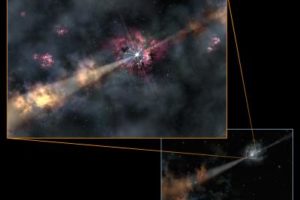gamma ray burst
Physicists discover Crab nebula is slowly dimming
BATON ROUGE — The Crab Nebula, once considered to be a source of energy so stable that astronomers used it to calibrate their instruments, is dimming. LSU physicists Mike Cherry, Gary Case and graduate student James Rodi, together with an intern…
It's a nova … it's a supernova … it's a HYPERNOVA
Two billion years ago, in a far-away galaxy, a giant star exploded, releasing almost unbelievable amounts of energy as it collapsed to a black hole. The light from that explosion finally reached Earth at 6:37 a.m. EST on March 29, igniting a frenzy of activity among astronomers worldwide. This phenomenon has been called a hypernova, playing on the name of the supernova events that mark the violent end of massive stars.
Quick action by astronomers leads to new insights on mysterious gamma-ray bursts
Scientists “arriving quickly on the scene” of an October 4 gamma-ray burst have announced that their rapid accumulation of data has provided new insights about this exotic astrophysical phenomenon. The researchers have seen, for the first time, ongoing energizing of the burst afterglow for more than half an hour after the initial explosion. The findings support the “collapsar” model, in which the core of a star 15 times more massive than the sun collapses into a black hole. The black hole’s spin, or magnetic fields, may be acting like a slingshot, flinging material into the surrounding debris.
Robotic telescope catches early afterglow of gamma-ray burst
A team of California astronomers announced today that its robotic telescope has captured one of the earliest images ever of the visible afterglow of a gamma-ray burst. The telescope started its exposures 108 seconds after the burst was detected by the HETE-2 satellite and continued for more than 2.5 hours, until brightening of the dawn sky halted the observations. The unprecedented record of the fading glow, captured Dec. 11, will help theorists as they puzzle out the physics of these bizarre cataclysmic events, which are heralded by a brief burst of energetic gamma rays and X-rays emitted billions of years ago and followed by a fading optical light.
Scientists catch their first elusive ‘dark’ gamma-ray burst
Scientists racing the clock have snapped a photo of a gamma-ray burst event one minute after the explosion, capturing for the first time a particularly fast-fading type of “dark” burst, which comprises about half of all gamma-ray bursts. A gamma-ray burst announces the birth of a new black hole; it is the most powerful type of explosion known, second only to the Big Bang in total energy release. This latest finding may double the number of gamma-ray bursts available for study and rattle a few theories as well, said scientists from the Massachusetts Institute of Technology, based on an X-ray image taken by the MIT-built High Energy Transient Explorer (HETE) satellite, the first satellite dedicated to spotting gamma-ray bursts.


